Happy Friday! Thanks for all the wonderful feedback you gave us yesterday on striking a balance between COVID-19 coverage and everything else that’s happening in the world. Trust us, we can’t wait to move on and write more about other things too … whenever that is.
Quick Hits: Today’s Top Stories
-
As of Thursday night, there have now been 1,417,512 confirmed cases of COVID-19 in the United States (an increase of 27,106 from yesterday) and 85,886 deaths attributed to the virus (an increase of 1,767 from yesterday), according to the Johns Hopkins University COVID-19 Dashboard, leading to a mortality rate among confirmed cases of 6.1 percent (the true mortality rate is likely lower, but it’s impossible to determine precisely due to incomplete testing regimens). Of 10,341,775 coronavirus tests conducted in the United States (366,944 conducted since yesterday), 13.7 percent have come back positive.
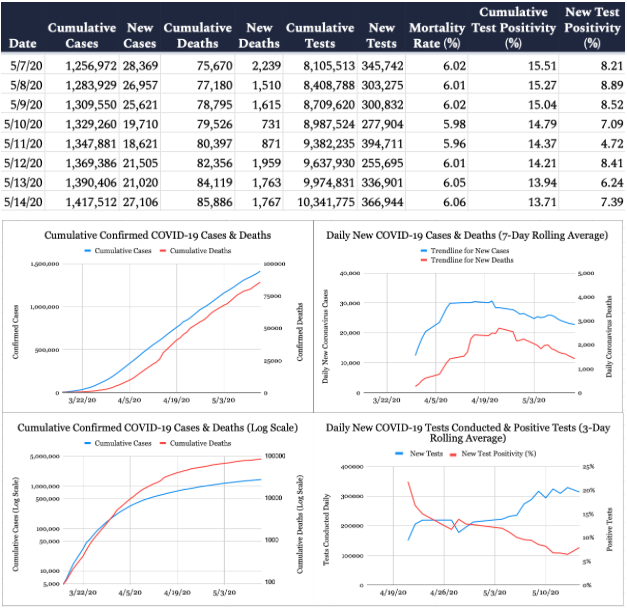
-
President Trump on Thursday called on Sen. Lindsey Graham—chairman of the Senate Judiciary Committee—to haul Barack Obama before the committee, insisting in a tweet that “he knew EVERYTHING” about “the biggest political crime and scandal in the history of the USA.” Graham pushed back in a comment to Politico: “I don’t think now’s the time for me to do that. I don’t know if that’s even possible. … I understand President Trump’s frustration, but be careful what you wish for.”
-
Ousted Health and Human Services Department official Rick Bright testified before the House Energy and Commerce subcommittee on health yesterday, claiming his warnings about the coronavirus back in January were ignored by the Trump administration and that a 12-18 month timeline for a vaccine is overly optimistic. President Trump dismissed Bright as a “disgruntled employee,” and HHS Secretary Alex Azar said “everything [Bright is] complaining about was achieved.”
-
Sen. Richard Burr, who is under investigation for allegedly using nonpublic information to dump stocks ahead of coronavirus-related market crashes in late February, has temporarily stepped down as chairman of the Senate Intelligence Committee.
-
President Trump requested the Supreme Court halt a lawsuit brought by Maryland and Washington, D.C., over whether payments to the Trump International Hotel by foreign and domestic governments are violations of the Constitution’s Emoluments Clause after an appellate court held it could proceed.
-
The Senate voted yesterday to reauthorize the Foreign Intelligence Surveillance Act. Some revisions were made to the House bill the Senate voted on, however, requiring the House of Representatives to vote on the matter once more.
-
The Senate also voted to sanction Chinese officials responsible for human rights abuses perpetrated against Uighur Muslims, millions of whom have been confined to “re-education camps” since 2017.
Escape From Shutdown City
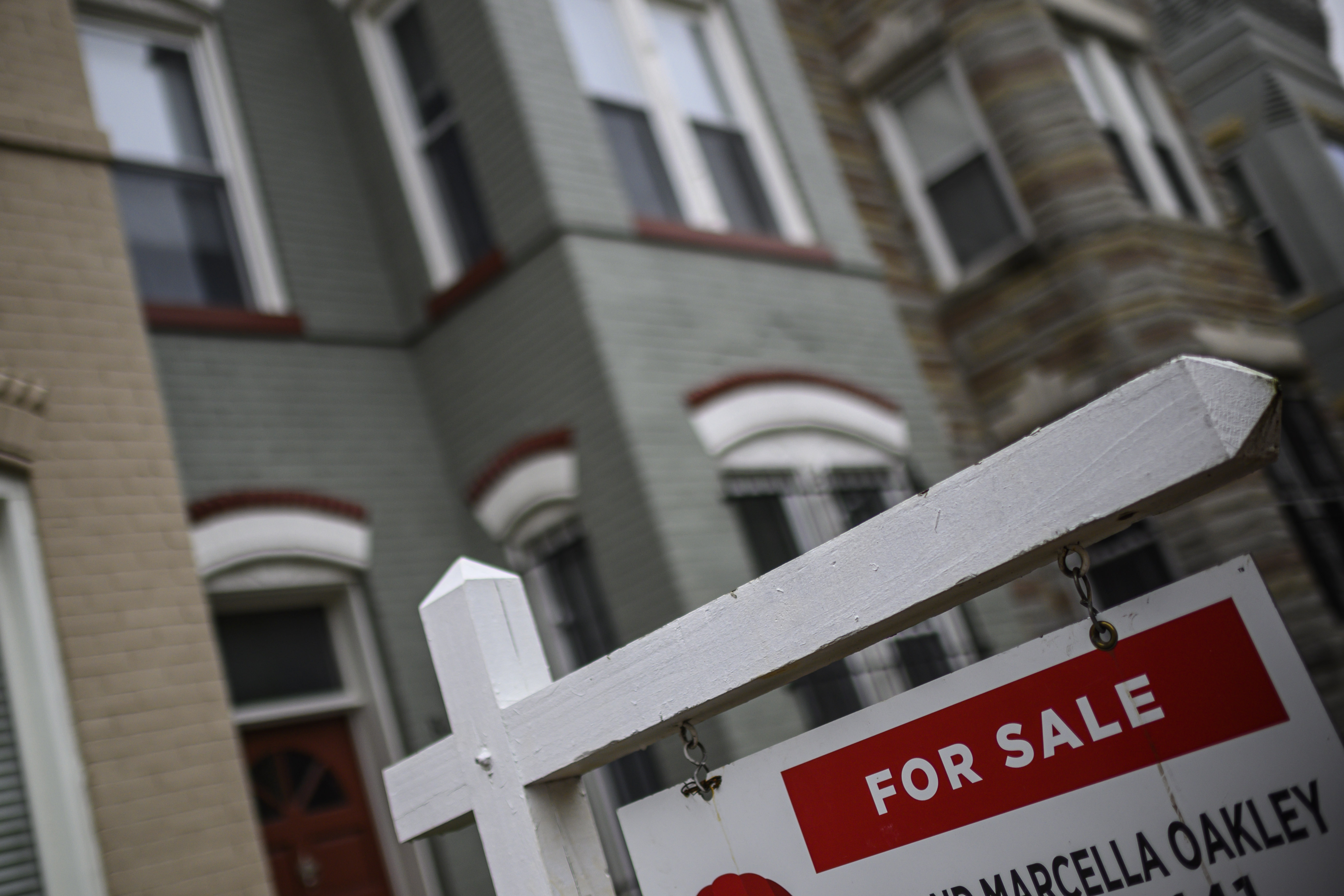
In the middle of a pandemic, it can be hard to spend much time thinking about what will come after. The most pressing question, of course, is how quickly we can defeat the virus and how we can minimize its damage to our health and our livelihoods. But another important question is: How different will the world look in the aftermath?
One big piece of that puzzle: Where will we live? A few months back, the first waves of serious coronavirus anxiety sent many urbanites scurrying for roomier pastures: If you’re a professional in D.C. or New York, odds are you know people who left to ride the pandemic out elsewhere. At first, it seemed obvious that these were temporary measures. But as lockdowns have continued to drag on, it’s become an open question whether moves away from the cramped conditions of city living will settle into a substantial trend. Data suggesting this may be the case is beginning to pile up.
Real estate website Redfin reported yesterday that page views for small-town and rural listings on their site skyrocketed in March and April and remain far above average.
In a National Association of Realtors poll earlier this month, 5 percent of realtors—a small but significant number—reported that clients were shifting their preferences away from urban areas to suburbs due to COVID-19. Meanwhile, a recent Harris Poll found that city dwellers were twice as likely as their suburban or rural counterparts to have recently browsed for a new home to rent or buy.
A spokesperson for Realtor.com, told The Dispatch that more people are looking at homes in the D.C. and New York suburbs compared to the cities themselves now than they were either before the shutdowns began or at this time last year, and that suburban homes are currently turning over more quickly and stagnating less often than urban ones on their site.
The trend here is modest, but real. It’s also surprising: Why would a crisis as seemingly short-term as an outbreak of disease be causing changes in behaviors as long-term as home ownership? The answer appears to be that the movers in question aren’t pulling up roots to flee the virus: Rather, the virus has so dramatically underscored the downsides of city life that it’s causing a bunch of people who’d already been thinking about a move to get serious about it.
For some people, Redfin lead economist Taylor Marr told The Dispatch, “they’ve been thinking about moving to the burbs for a while, they’ve been casually browsing, but this is sort of the straw that broke the camel’s back.”
For many urban professionals, city living is largely premised on spending the least amount of time in your home as possible: you pay far more for far less space to have convenient access to your work and to cultural and leisure activities. Now, if all your work and leisure is taking place at home, too, all you’re left with is paying more for less space.
“One of my current clients has a studio apartment in Southwest,” said Katie Moore, a real estate agent at Engel & Völkers in Annapolis who sells properties in the Maryland exurbs some 30 miles from D.C. “He reached out to me like, ‘I’m so tired of looking at these four walls—I need land.’”
These trends also reflect a growing sense among many professionals that working from home is likely to outlast the pandemic. Not in the sense that jobs will go fully remote—according to Marr, a big chunk of that rural home browsing, particularly back in March, was likely just “head for the hills” disaster theorizing—but that many people expect to be physically at work less frequently, making substantial space at home more important and a convenient commute somewhat less so. Moore said, for instance, that she has seen an uptick in buyers looking for homes that could accommodate two home offices.
“Most people don’t work full-time remote, and even in the future it won’t be the majority that work remote completely full-time,” Marr said. “Instead what’s way more common is just that people occasionally work from home on a Friday, or they don’t commute in every day. I think we’ll see an acceleration of that going forward … Instead of people saying, ‘I’m going to move from D.C. to rural South Carolina or North Carolina, they’re going to instead think, ‘Well, I’d be okay with a longer commute.’”
A Dispatch From a New York ICU Doctor
Up on the site today, we’ve got a really great piece from Dr. Benjamin Daxon, a Mayo Clinic ICU intensivist and military veteran who left Minnesota in late April to help a hospital in New York City overwhelmed with COVID-19 patients. “My wife and I realized I needed to go,” he writes. “I couldn’t stand the thought of my grandchildren asking me in 40 years: ‘Grandpa, you were an intensivist at Mayo Clinic during the great COVID pandemic of 2020. What did you do?’ and me replying, ‘I sat around and watched my colleagues get furloughed.’”
He kept a journal throughout his time there, and, although it’s long, we really encourage you to read all of the entries to catch a glimpse of what it’s like on the pandemic’s front lines. Here’s one day’s edition:
April 25 at 9:52 a.m.
Night 1 is in the books. It was both really good and really bad. The unit was busy and the patients were sick. Some really sick.
The shift started with NYC Mayor Bill de Blasio visiting and giving a pep talk to everyone from outside the main entrance. Firefighters, paramedics, police, etc. were there too. It was touching, encouraging, but it wasn’t well timed. It occurred at shift change and really disrupted everything. Overall, though, it was worth it. Unfortunately, at the conclusion of his remarks, Mayor de Blasio asked if everyone could gather in for a picture. We would have all done a collective face-palm at the irony of his request if it weren’t for the fact that we weren’t supposed to touch our faces. I’m still glad he came.
Back in the unit things started off with a wonderful surprise. There was a sudden eruption of applause and cheering from one corner of the unit. Everyone rushed over and joined in as we all celebrated a patient who was leaving the ICU after being extubated three days prior. It was great. There’s no Rocky theme song for that, but there should be.
After that we, the night team, got sign-out from the day team. We all walked around to each patient and briefly reviewed the patient’s history, what was done during the day, what still needed to be done overnight, and things to be on the look-out for. Covering the unit with me was an ER doc from Michigan, a GI fellow from the hospital, and a cardiology fellow from a neighboring hospital (see a picture below). It was great to have such a diverse group. I’ve had physicians lament that they can’t do much because they’re not trained in critical care. Nonsense. I’m trained in critical care. What I’m not formally trained in is cardiology, gastroenterology, and emergency medicine. We could draw on each other’s knowledge so that collectively we were better than if we had all been trained in the same thing.
Things were rough after that. The first day/night to manage a unit is usually the toughest because you’re just learning the patients. This night was no different. There were 21 patients and most everyone was intubated, in multi-organ failure, and on dialysis. To make matters worse, all the equipment was foreign to me. And most of it was outdated. A lot had been brought in by FEMA. When people talk about how New York never ran out of ventilators, it’s like giving a military unit a bunch of muskets and sending them to Afghanistan and telling everyone that they all got a rifle. Technically true; practically false. I spent a good chunk of time trying to find better ventilators in the hospital and get my patients switched over to them.
By the morning, no one was extubated but everyone was the same or better than when I came on. That’s a win in any intensivist’s book. Even though everyone on my team was out of their usual role, exhausted, and stressed, I never once heard a complaint or saw anything less than full devotion to the patients. And just for perspective, the ER doc has literally worked the last 19 nights in a row. She has seen a lot of death and dysfunction. I don’t know how she still keeps her head about her. It’s really impressive.
Worth Your Time
-
Depending on where you’re getting your news, you’re likely hearing about two reductive paths forward in the age of COVID-19: The Democrats want to keep the country locked down indefinitely—ignoring the economic ramifications for doing so—while Republicans want to open things back up immediately—ignoring the loss of life that could result. But, as with most debates, things aren’t so black and white. Take this New York Times piece from Johns Hopkins surgeon Dr. Marty Makary. “The choice before us isn’t to fully lock down or to totally reopen,” he writes. To reopen safely, he says we need to: practice universal masking, spend more time outside, adapt businesses, safeguard nursing homes, and protect those at higher risk.
-
As we’ve detailed in the past, a lot of coronavirus modeling has ended up missing the mark pretty significantly. But Nicholas Reich—a biostatistician at UMass Amherst—is trying something different: Combining all the models together. His forecast is sobering—110,000 COVID-19 deaths by June 6—but you can read Nurith Aizenman and Sean McMinn’s writeup of Reich’s methodology for NPR here.
-
David Byler, a Washington Post data analyst and Weekly Standard alum, has a fascinating analysis of Donald Trump’s approval ratings in the context of coronavirus. Despite the missteps of the federal government’s handling of the crisis, Trump’s approval rating remains roughly where it was before the pandemic. “That’s because Trump is likely still in the middle of a grace period: Voters aren’t holding him fully accountable for the damage caused by the virus. If Trump can right the ship or simply elongate this reprieve, that might be enough for him to win reelection. But presidential history suggests that even a norm-defying president like Trump can’t escape the pull of basic political gravity. Voters might be willing to give a leader leeway in a crisis, but they won’t extend that credit indefinitely.”
Something Fun
We concur with the poster: Watch til the end.
Presented Without Comment
Also Presented Without Comment
Toeing the Company Line
-
Struggling to keep tabs on what in the heck is going on with Michael Flynn? Let David’s latest French Press (🔒) get you up to speed. “Republican senators released a list of Obama administration officials who ‘unmasked’ Michael Flynn’s identity in intelligence reports. ‘Unmasking’ refers to the practice of revealing the identities of American citizens who are mentioned or referred to in the course of foreign intelligence surveillance,” David explains. “Absent unmasking, the American might be simply called ‘Person 1,’ and their unknown identity can hamper the ability of appropriate officials to understand the importance or context of communications.”
-
Historian Paul Matzko joined Jonah on the latest Remnant podcast to talk about the legacy of talk radio and the conservative movement. Turns out, the relationship between the two goes back much further than Rush Limbaugh and Michael Medved. Tune in here for a really interesting discussion.
-
There was a lot of legal news this week! Sarah and David break it all down in yesterday’s Advisory Opinions podcast. Unmasking, SCOTUS oral arguments, President Trump’s financial records, faithless electors, Wisconsin administrative law—this podcast has it all. Tune in here.
-
In an interview with Fox News Business’ Maria Bartiromo on Thursday, President Trump claimed Dr. Anthony Fauci disagreed with him on “closing the border to China.” Alec investigated, and turns out those comments contradict what both he and Fauci have previously said many, many times. Check out his latest Fact Check here.
Let Us Know
Readers living in suburbs or smaller towns: What are the biggest benefits of non-urban life in the age of COVID-19? And for you city slickers: Do you remain committed to your cozier existences?
Reporting by Declan Garvey (@declanpgarvey), Andrew Egger (@EggerDC), Sarah Isgur (@whignewtons), and Steve Hayes (@stephenfhayes).
Photograph of a house for sale in Washington, D.C., by Eric Baradat/AFP/Getty Images.
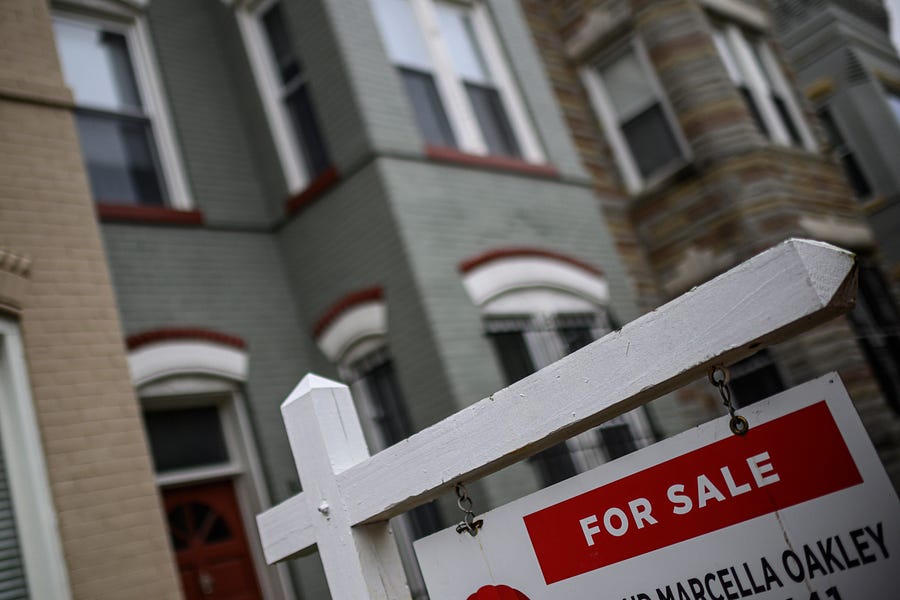

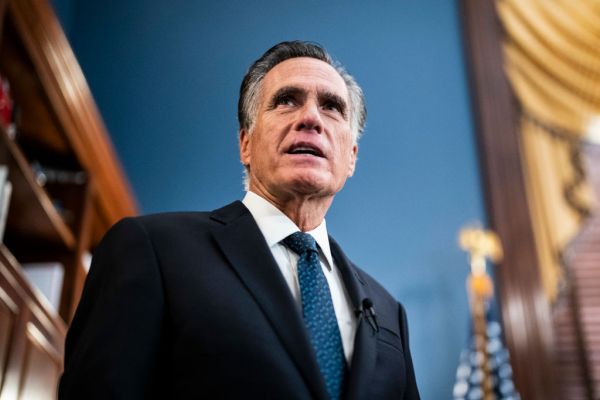

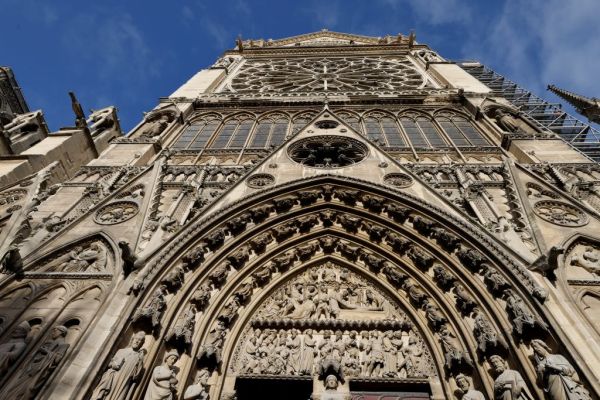
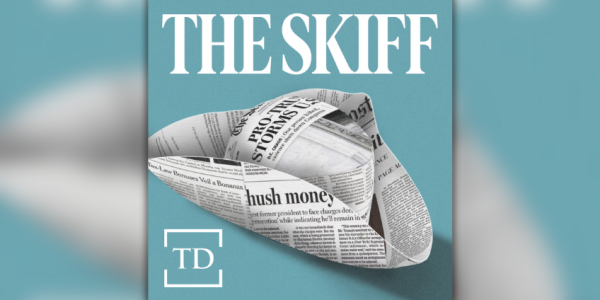
Please note that we at The Dispatch hold ourselves, our work, and our commenters to a higher standard than other places on the internet. We welcome comments that foster genuine debate or discussion—including comments critical of us or our work—but responses that include ad hominem attacks on fellow Dispatch members or are intended to stoke fear and anger may be moderated.
You are currently using a limited time guest pass and do not have access to commenting. Consider subscribing to join the conversation.
With your membership, you only have the ability to comment on The Morning Dispatch articles. Consider upgrading to join the conversation everywhere.